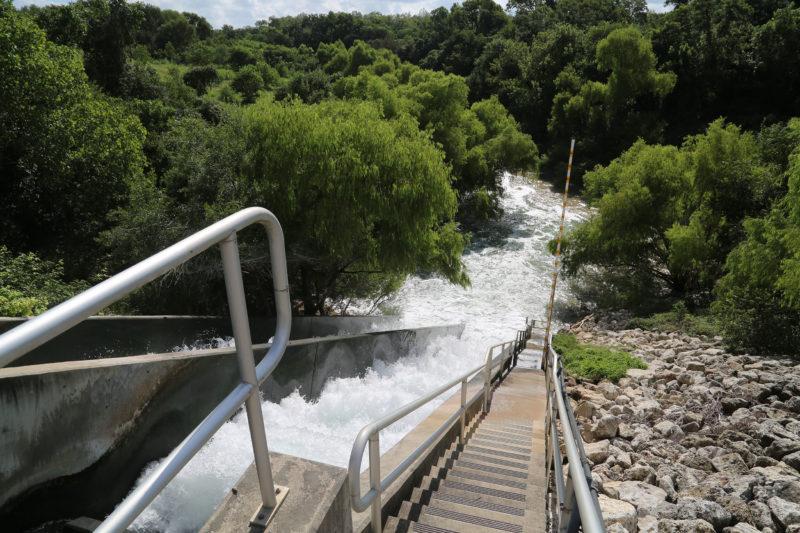Trinity collaborated with SAWS in 1999 to establish the water recycling program used today through campus.
In 1999, Trinity started irrigating the campus with recycled water. The switch came about after the San Antonio Water System (SAWS) began an initiative that ultimately made better use of wastewater in an attempt to conserve drinking water.
At the time, SAWS was implementing many recycled water towers throughout San Antonio, including the one just north of campus. Both institutions saw Trinity as a perfect model for this new recycled water system.
“In the late 1990s, it became apparent that the Edwards Aquifer would become more restricted, so the SAWS Board of Directors and the city decided to diversify water supplies. One of the most ready ways to reuse water was this highly-treated effluent,” said Anne Hayden, SAWS communications manager.
Although the idea of using effluence to irrigate the landscape may seem dangerous or unsanitary, the water goes through a long process of cleaning to ensure that it is safe.
“It’s a step away from being drinkable and is considered river water. It lies within 100 feet from the outflow source, is completely potable, and considered a great option,” Hayden said.
The water is drought-proof and unrestricted. For these reasons, many find it to be the best option for landscaping among other things; these places include most of the golf courses in San Antonio, Fort Sam Houston, USAA and Microsoft’s data storage plant.
“At the time, the Trinity administration was just beginning their commitment to sustainability, so they thought this would be a good place to start,” said Mindy Morales, computer aided design (CAD) technician of the campus planning and sustainability department.
As water started to get scarcer, SAWS began to implement this system of recycled water. The plan has since been carried out in other institutions like Trinity, golf courses and parks throughout San Antonio.
The recycled water is only used for irrigation and can be beneficial in the summer time or in the case that the city experiences a drought, when water is more carefully conserved out of necessity. Many San Antonio residents are given a specific date and time that they can water when the aquifer levels are low, but since Trinity uses recycled water, there are no such restrictions on the usage.
“When we have a campus this big, it’s impossible to water everything one day a week, so this allows us to keep the landscape evenly watered. This ensures us that, even during drought, we can at least keep the landscape alive,” Morales said.
The piping for the recycled water must be completely separate from all other piping to ensure there is no chance for cross-contamination. Because of this, new purple piping was put in, which took nearly the entire summer of 1999 to complete.
“There were a few areas that we couldn’t get right away, but we added those later on. There’s only one spot on campus that’s not covered: the Ruth Taylor courtyard. It’s completely surrounded by buildings, so it’s impossible to get special piping put in there,” Morales said.
Regular water is used there instead. The recycled water on campus is transported from Dos Rios, a water processing plant south of town. After it’s processed, the water looks clear and has no smell.
“Rather than dumping the water back into the river, SAWS started shipping it back up here,” said Richard Reed, professor of environmental studies. Although some speculate that the water is harmful, chlorine is added to kill any bacteria that is in it. There is also concern that the water may be harmful for vegetation.
“The golf courses are the ones who monitor their grass the closest, and they don’t report any problems. My gut on this is that there is little or no change in the foliage, the landscaping,” Reed said.
However, Reed does mention the concerns he has with trace elements in the water. Although the water is treated to kill bacteria in it, other things exist in it that may or may not be harmful.
“They can kill the bacteria. There’s no live bacteria, but what does exist in this water that I think we should pay attention to are heavy metals, pharmaceuticals and a whole range of trace elements that you don’t take out of the water. There’s a reason they don’t want this stuff to go back into the river,” Reed said.
Trinity’s efforts to conserve can be seen as a step towards creating a more eco-friendly, sustainable campus. However, there is much more to come.
“It’s a result in change of attitude; it’s a combination of the commitment that Trinity made, but also a generational change. I find that students are immensely more likely to be conscious with things like recycling,” Morales said.
Trinity will continue to use this recycled water for irrigation on campus, and SAWS intends to spread the initiative to other companies and institutions like Trinity.







